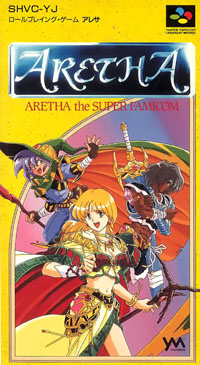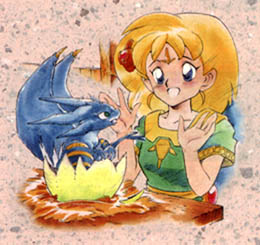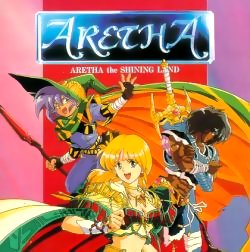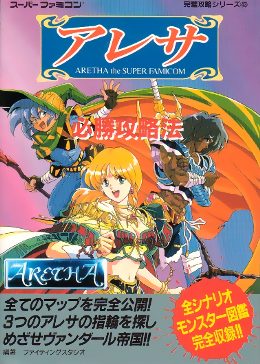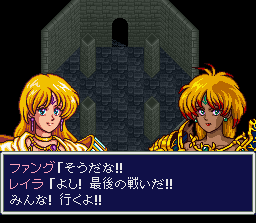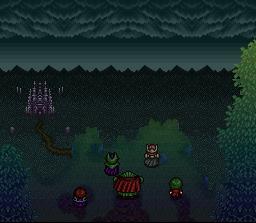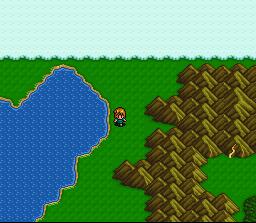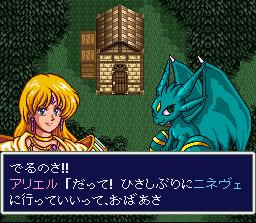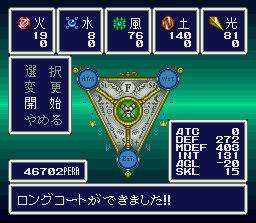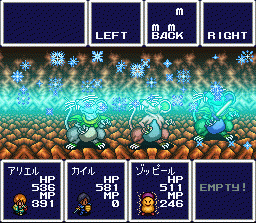--------THE JAPANESE "CLASSIC" RETURNS ON THE SUPER FAMICOM--------
Aretha...Aretha...Aretha...where do I begin? Well, if you haven't heard of Aretha, I can't say I'm too surprised. This game, Aretha: The Super Famicom, is named the way it is because the game didn't originate on the Super Famicom. The series originally started on the Game Boy (The Game Boy has three Aretha games) and this is the first Super Famicom Aretha game in the Aretha series. The series is published by Yanoman, a company that was founded on January of 1954 (with it being established on December 1959) by a man known as Yano Kazunari. As you can tell, Yanoman is generally named after its founder. Yanoman was, and still is, a company best known for its jigsaw puzzles, "YM Books", and card games, but they also published a few games too, mostly in cooperation with JAM (Japan Art Media). The company is also popular thanks to Mizuki Shigeru (whose real name is said to be Takashi Shigeyoshi). Mizuki Shigeru is the creative mind behind one of the most popular cartoons in Japan, Gegege no Kitaro and Yanoman has gained a good deal of fame for selling various products that revolve around GnK. Yanoman even sells popular Disney merchandise!
Originally, Aretha dealt with a young and feisty babe named Materia Weathers. Materia was found when she was a child by a man named Floyd, who then raised her and taught her various fencing techniques to defend herself in the wild demon infested Aretha Kingdom. Since I intend to cover the first Aretha game in the future, I'll cut to the chase and tell you that an evil magician named Howard was trying to rule over the Aretha Kingdom. Being dubbed a "Demon King", Howard felt that he had such great power that no one could stop him, but in the end, he loses to Materia and her friends...blah, blah, whatever. A:TSF is the fourth game in the series and it no longer deals with Howard, although his dark legacy is still mentioned. This game deals with a young girl named Ariel (Although she quickly matures after about ten to twenty minutes into the game) who lives in a quiet forest with her grandmother, Seara. One day, she runs an errand for Seara and during the errand, a series of unusual events unfolds and Ariel acquires a dragon egg.
After briefly playing through her childhood, the game truly begins, and Ariel is now 17 years old and Fang (the dragon) is 7 years old. One day, she meets a suspicious old man who knows more about Ariel then she knows about herself...and he tries to trap her in a cave on a mountain to leave her to die! However, Ariel and Fang discover a powerful magician named Doll, who uses his power to bust them out of the cave. After that, Ariel returns home, only to find her house burned to the ground...and Seara is gone. Realizing that she doesn't know much about herself, she sets off on a journey to discover her purpose. Ariel doesn't yet realize it herself, but she is only "half" of herself, because she was split into two different beings. Her quest will take her across the Aretha Kingdom doing various good deeds and various pointless things along her journey to become whole again.
However, a dark being is trying to enter the Aretha Kingdom and control the land...if he succeeds, the world may be plunged into chaos and it will be like Howard all over again! There are various people who seek to aid the dark one as he prepares to enter the kingdom and they will thwart Ariel's efforts whenever it is possible...At any rate, Aretha is very text heavy and filled with lots of "filler" dialogue (tons of "Arigatou!" and other typical Japanese conversational words), but there is a fair and "classic" plot. You don't have much in the way of romance or drama, but you do have a spy and a pinch of occasional humor. I guess with all the fetch quests and do-gooding going on, Ariel just doesn't have time for any personal relationships...eh, it's OK. One thing I should note is that the magician, Doll (On the far left of the box front), is an important member in the series who appears in every Aretha game.
--------WITH A NEW HEROINE COMES A FRESH COAT OF PAINT--------
I will be somewhat lenient because Yanoman and JAM aren't companies that you may typically hear anything about. Actually, up until now, you may be reading this little passage and wondering why you should even care if they are just some forgotten companies in gaming? The truth of the matter is, while Aretha may seem like an ordinary game, it is actually one of the better Japanese RPGs for the SFC and it isn't as simple as it may seem either. The visual presentation of Aretha is actually quite satisfying. The graphics are fairly simple SNES stuff with simple sprites and animation. However, many of the environments are rich in color and really bring out the many colors of the SNES/SFC hardware. One example is the "Rainbow Kingdom", a kingdom full of furry beings who originated from the original Aretha. The area has flashing lights that change color and the town uses a broad range of colors. The game also uses some basic mode 7 effects and the battle backdrops are designed respectably well. Spells look good and the spells get more impressive as you obtain higher levels of magic. Everything is smooth and the images are sharp and clean. As you may have expected, the game did a good job with giving the Aretha series a much needed fresh coat of paint. The music, on the other hand, is very generic stuff. Hard to say how I feel about it...it's one of those things that fall in the middle. Simply put, it's not annoying, but it could use some work. Some tracks are good and give the feeling that you are going on a merry adventure. Others are repetitive in a way that I find a bit bothersome. Truthfully, the music is too "samey". Too much of the music in the game sounds too similar to one another. Overall, it works, but it is quickly forgettable.
--------A LITTLE MORE NEW STUFF, A LITTLE LESS OLD STUFF--------
The Aretha games for the Game Boy were strange to say the least and while the first SFC Aretha production seems to have strayed from the original beaten track, the game still has a few unusual elements about it. Ariel starts with basic equipment and a couple of basic spells. However, if you are a complete level-up freak who likes to over-train your characters, you may or may not notice that no matter how many times Ariel levels up, she doesn't develop any new skills. We at Gaming Sanctuary own the manual and such for this game, so we know how it works, but gaining abilities in Aretha may seem like a complete mystery to those who don't understand that Aretha, while looking traditional, isn't exactly traditional in terms of form and function. Gaining magic in Aretha is a chore because you have to keep using magic in order to learn new skills. There is no indicator (that I know of) that lets you know when you get new magic...you're just SUPPOSED to know. After finishing a fight, you may learn a new spell or two if you've been using spells. Unfortunately, this means that you will have to use crappy magic a good deal before you get anything that can truly help you out and Ariel and Doll are the only two characters whose skills can be developed. Special characters that join come with a preset list of skills that don't change. Seriously, Ariel can kill enemies with her staff in one hit...why even use magic?
Well, Aretha has an unusual combat system where enemies can appear from the "LEFT", "BACK", "RIGHT", and of course, in front of you. However, all the enemies are really "IN FRONT" of you, so to speak. By hitting the L or R buttons, you can look around to fight enemies in the aforementioned directions. This can prove to be important to a degree because potentially strong monsters may be hiding in another rank, so it isn't always the best decision to fight the enemies right in front of you. Getting new magic is important because battles can become long and boring very quickly if you simply kill them one by one. Magic can hit groups of enemies (the ones right in front of you) or all enemies (LEFT, RIGHT, BACK, and FRONT), which can help you quickly eradicate waves of enemies. Magic also has more spark and flair than a mediocre club whacking session (obviously) and it IS useful (even if obtaining magic takes forever at times). As far as magic goes, you have the typical assortment of healing, attack, and support. Aretha also has a couple of characters who don't obtain any magic and are strictly warriors. Those of you who are familiar with Arguro from Lufia/Estpolis may be able to relate to Aretha in that sense. Fang is an exception to the rule because he does not obtain magic, but he can breathe fire breath on his foes, though I found his fire breath to be mostly useless.
Besides the combat system, Aretha has other characteristics that are interesting. Your heroes have a limited item carrying capacity, but not in the way you might suspect. You are limited to fifty or so in each item category (Healing items, magic/combative items, and equippable items), but you can't carry fifty of each, but fifty TOTAL. For example, you can choose to carry fifty healing potions, OR you can carry one of each assist item instead. If the going gets tough, you can carry 15 potions, five of each status abnormality healing item, etc. The idea behind it was to carry items strategically, but also somewhat more flexibly than being limited to carry 3 or 5 of each different item. However, the enemies drop so many items that you constantly have to toss stuff just to find out the contents of treasure chests and the like and you can also search different things to find hidden items (barrels, boxes, etc.). The game also has an item creation system where you can create various pieces of powerful equipment using the elemental souls of defeated monsters. Being known as the "Mikusutofoomu", or in English, the "Mixed Form", the Mixed Form is a triangular device that allows you to mix three different elements together to craft equipment. However, the game is flawed because if you use a few souls early in the game, you can get some truly wicked equipment, making the game a cakewalk for nearly the entire game.
The strange thing is that the more of each elemental soul you use, the weaker (in several, but not all cases) your equipment will be. You will get to use Mixed Forms that allow you to allocate more souls and you can create godly equipment at the end of the game, but the game is easy enough with the items that are easily available to you where getting ultimate equipment with say...97 fire souls, 79 water souls, and 89 wind souls just seems like a waste of time (not the best example, but one of them I believe). Also, depending on the amount of each different element used, you can make an item you might have made before, but it will be more (or less) powerful. Experimentation is the key. Dozens of items can actually be made from the Mixed Forms in the game and it would have been awesome if the items you made early in the game weren't so strong. Unfortunately, strong equipment is really what you need in this game because the encounter rate is truly absurd at times. The encounter rate, combined with a nearly endless supply of random and unnecessary dialogue, make Aretha a VERY slow game in terms of progression. There were several points where I was saying to myself: "Are we done yet? Are we DONE yet?".
--------BOOBS AND SIDE-QUESTS...TOGETHER?--------
However, Aretha did try to make a lasting impression and the game did prove to me that it possessed a concentrated effort. The game even has sidequests and several hidden items, including an item that is popular in the Aretha series...the "Testament", an item (at least in this game) that boosts all party members to level 99! Talk about rewarding! However, I can't tell you how to get it in this article because that would be cheating. Another interesting item I came across was the "Trinea", an item that restores the whole party's HP and MP and it is infinite (but only usable on the field). It, like the Testament, is an incredible item, but more importantly, the inner nerd in me appreciates the Trinea more for its symbolic value rather than what it does in the game itself. The item was named after another Yanoman published title, known simply as "Trinea", and the item is a tribute to the game. Trinea is also known as "Penta Dragon 2" and the original Penta Dragon also originated on the Game Boy, just like Aretha did. You also have an item that lets you buy support items anywhere known as the "Millennium". It think it sucks compared to the other two, but it has its uses.
The game also lets you get access to an "Aretha CD", which acts as a sound test where you can listen to the music...I personally didn't find it all too rewarding, but if you play this game, you may want to try to obtain it. While it isn't a sidequest item, you also get a monster book which acts as a bestiary, which is pretty cool...lastly, I should say that Aretha contains some suggestive themes...namely...boobs. Shockingly enough, there isn't just one, but two enemies that show you one of their boobs; A Harpy enemy and a Medusa enemy. Also, their color swapping variants also show you a boob, so really, there's about a half a dozen or so enemies who do it. It's only one boob and it's not exactly over-the-top "OMG! SHE GOT TEH BOOBZ!? PERVERT! OMG!", but you've been warned anyway. I personally found it surprising, considering that Nintendo was known to be so sensitive about censorship.
--------BEING AVERAGE ISN'T ALWAYS A BAD THING--------
After revisiting Aretha: The Super Famicom, I think that the game doesn't have any real replayability and one completion of the game is more than enough since the game is long. If you are trying to unlock everything and get the most powerful equipment, the game can take a while to complete...I'd guesstimate roughly 70 hours. The visuals are solid, but the music is average and the game is pretty easy. It's a playable game...one might even call it an "excellent average" game...I guess it's slightly above average. The game had a lot of potential and interesting concepts and it should appeal to those looking for a "classic" RPG, but if you are looking for something with more flair, this game may not be for you...oh, and did I mention that the game has boobs?
- Written by Vyse the determined - |
